#i am not primarily a novelist or a youtuber
Explore tagged Tumblr posts
Text
Sometimes I forget that I am a coffee company.
#memory#coffee#i am not primarily a novelist or a youtuber#i am mostly a coffee company#that donates its profit to charity
1K notes
·
View notes
Text
"How people think"-- I mean, what their experience of consciousness is like-- is so fascinating to me. It seems to vary a lot even within groups like "autistic people" or "NTs" & everyone typicalizes their own experience (naturally)! I would be so interested in more non-judgmental, non-humblebraggy discussions of this that also didn't assume differences could be reduced to "are you NT or 'neurodivergent' (almost always implicitly meaning, specifically, 'an autistic person without intellectual disabilities')."
For example, it doesn't surprise me that many people lack internal monologues. I do have one, although it's usually more like an internal dialogue or conversation, but I do enough thinking outside of that to imagine it.
I AM surprised that linguistics youtuber Simon Roper says he has no internal monologue, though, because the thinking I do that isn't verbal-linguistic and doesn't have a strong "I" perspective is typically extremely difficult for me to put into words at all. Often, as I try, I feel the understanding actively slipping away from me or becoming confused as I attempt to phrase it-- it won't work for me in words, or at least not in the English language. But Roper appears to totally lack this problem, & is very articulate on a number of conceptually sophisticated, fairly abstract subjects!
The concept of aphantasia was more surprising for me to encounter. I suppose the best way to explain why is to share the anecdote that growing up, I always felt my imagination was kind of weak because it takes great effort and will for me to actually, in a literal sense, make myself Really See the phantom image of something before me. Most of the time, I can "only" picture things inside my head, I can only sound-picture music in my head/create a simulation of hearing as opposed to literally hearing it.
Later, I would find out that the amount of time other people imagine something and actually see or hear it is basically "none times ever," so my assumptions were pretty off-base there! But yeah, my sensory imagination is strong, except for taste. I also have some degree of synesthesia (primarily audio/music--> color/pattern/shape), which...you know, I live here! In my brain! I don't have direct access to how others perceive the world! A lot of the books, poetry, even cinema I encountered growing up suggests that more people think like I do in these respects than is probably true, which I'm guessing is a combination of people who think like me being somewhat more likely to become poets/novelists/artists/etc., and poets/novelists/artists/etc. who don't think in this way using vivid, unusual dreams/daydreams/sensory imagery for literary effect
12 notes
·
View notes
Text


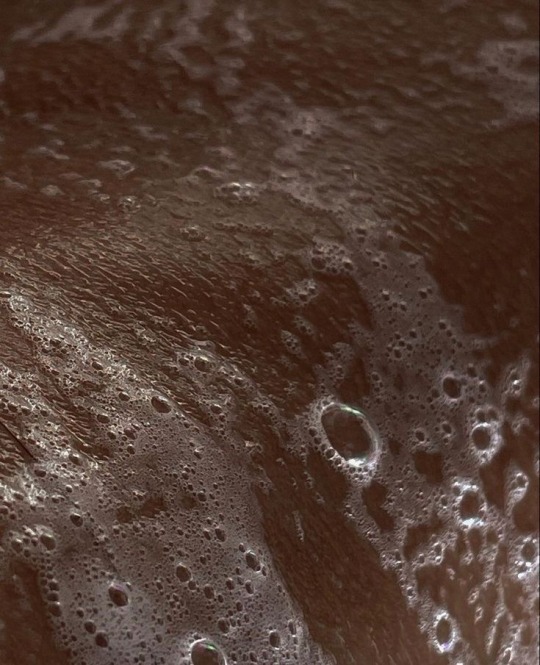
Hello Lovelies🤍
The best day is…
Rest day! Today is my rest day. I made it through yesterday after missing my boxing class and doing a YouTube Muay Thai workout + some lower body exercises as well, plus Barre in the evening. The Barre class was brutal as always but I feel that I did a bit better than normal (especially since I didn’t use the resistance band as much to focus on form). I’m happy with than and proud I stuck to my intentions, but my body has definitely had it! 😂 So today I am going to listen to CDs, clean my room, do laundry, have a little self care moment (my skin has been looking rough), and read, journal, have some tea, and write. I hope you guys have or are enjoying a rest day as well!
Do you guys have any music you’re currently addicted to? I’m loving listening to my Ultraviolence CD on repeat and scrolling through the girlblogging tumblr tags and my Pinterest boards. Also hyping myself up for life with Beyoncé’s new album, which I believe makes it the second time I’ve mentioned it on this blog. 😂
I also enjoy my personal CD that I burned myself, as well as Cesaria Evora and any opera or Gregorian chants. It’s reminding me that I’m going to be doing a lot of singing very soon…
I also thought I might put my current reads here! I’m reading American Psycho by Bret Easton Ellis primarily, then Women, Race and, Class by Angela Davis which I highly recommend if you live in the U.S. since it examines the evolution of the feminist movement here with an intersectional perspective as well as shows the roots of black women’s societal position/gender roles in the context of us being brought here and living here as slaves, along with so many other things I’m sure it will enlighten me about! I’m also reading A Happy Death by Albert Camus and Giovanni’s Room by James Baldwin—let me just say I love Baldwin’s prose and style. Every time I read James Baldwin (the last I read was in AP English; Go Tell It On The Mountain) I am just marinated in the most luscious use of the English language I have ever experienced. His words are both delicate and firm—I am convinced you will always get the message he is communicating along with the beauty of his story and to me that makes a very talented novelist (who, of course, wishes to send a message—some do not). I clearly enjoy my books.
I hope you have a lovely day, and let me know if you’re reading anything interesting! I love to have new books on my list. Except for Ayn Rand. 😐
Anyway, always love yourselves and know that you are worthy of kindness; both from yourselves and others 🤍
also—I’m planning on putting some workouts here from leg slimming exercises i’ve seen around and my personal preferences. if you’re interested then stay tuned for that! 🧚🏾♀️
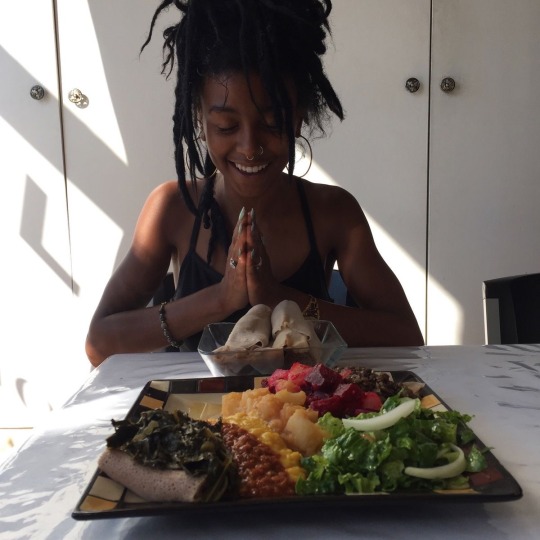


#girlblogging#green juice girl#healthy weight loss#lana del ray aka lizzy grant#poc girlblogging#hot girl shit#not pr0 anything#it girl#pink pilates princess#that girl#notpro4n4#model#model inspo#kate moss#naomi campbell#pinterest girl#self care#self worth#90s supermodels#high fashion#soft life#sora choi#personal blog#westcoastbb777✨#aesthetic
4 notes
·
View notes
Text
Episode 45 Review: Bob Costello’s First Episode

{ YouTube: 1 | 2 | 3 }
{ Full Synopses/Recaps: Debby Graham | Bryan Gruszka }
At long last, welcome back to my review series for Strange Paradise, a show increasingly living up to its name. In 1969 PT, the audience for this episode--primarily young people and housewives smitten with Colin Fox--is watching Jacques threaten Alison’s life if Vangie tells anyone about the events on Maljardin after leaving. Meanwhile in our timeline, the story takes a different, more bizarre direction, featuring an allegedly evil rabbit, a bloodied locket that once belonged to Erica Desmond, and an emergency séance that ends in a poisoning.
Now that former Dark Shadows staff member Robert Costello has taken the helm as producer, there will be many changes to the show, including a change in writers. Co-creator and former headwriter Ian Martin is gone now, and in his place we have George Salverson and Ron Chudley. Salverson was a prolific writer for Canadian radio and television, writing (among many other works) a 1949 radio adaptation of Dracula that’s very good and at least four scripts for the 1967 historical comedy TV series Hatch’s Mill[1], which also starred Cosette Lee and Sylvia Feigel and featured Kurt Schiegl as Big Kurt. Chudley was an up-and-coming writer who, like fellow SP writers Ian Martin and Harding Lemay, became better-known for his later work. He is still alive as far as I can tell and works as a novelist and playwright. The resume on his personal website lists a wide variety of works, including a series of mystery novels, one published play (After Abraham), and many scripts for different media, including “over one hundred [TV] scripts, for CBC and independents.” Salverson and Chudley will only write the next five episodes, but one of these (Episode 47) will be among the best of Maljardin.
From now until Episode 149, all episodes will open with new, Dark Shadows-style narrations delivered by cast members. The first, read by Angela Roland (Vangie), is rather vague and--surprisingly--doesn’t recap Holly’s poisoning:
Death lives in this great house on Maljardin, striking as swiftly as a bolt of lightning. Legend says it is caused by the evil of this man [Jacques Eloi des Mondes], three hundred years dead:

But others believe it is something more, like the Reverend Matthew Dawson.
The reason why she mentions Matt of all characters is because he appears first in this episode, lamenting the fact that Alison hasn’t yet verified whether or not his twenty-year-old stalkee Holly survived the poisoning attempt at the end of last episode. “Murder is a three-hundred-year-old tradition here on Maljardin,” he comments, speaking to the portrait which he refuses to believe is animate. “Do traditions ever die?”
“Murder, Reverend Dawson?” Vangie asks, which triggers a discussion of who could have poisoned the wine that Holly drank. Was the culprit her mother who poured it (and whom Vangie and Raxl have identified as a dangerous witch)? Was it Raxl, who filled the decanter? And could Holly have drank the cyanide that Jean Paul took from the lab in Episode 23, which has been missing since? We soon get an answer to the third question, courtesy of Holly’s mother Elizabeth:
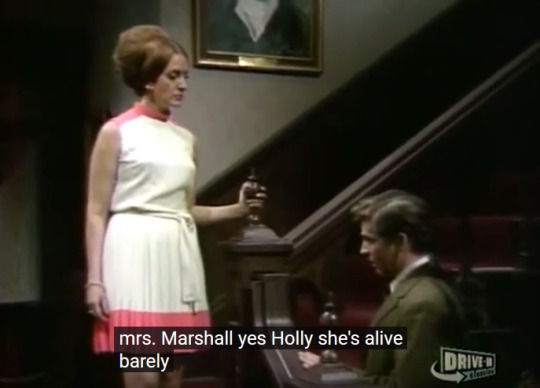
Well, that was quick.
“They tried to murder my daughter,” she accuses. “What will they do to the rest of us?”
“They?” Matt asks, confused. “Who?”
“I filled the glass, Raxl filled the decanter, and where was Jean Paul?” She asks about the master of Maljardin with a tone of accusation, evidently suspecting him of playing some role in the attempted murder. This is the first time on this show that one of Colin Fox’s contractually obligated absences has been worked into the plot in a way that makes sense, and I think it’s brilliant. His absence from the second séance provides her with a realistic and believable reason to accuse him of having something to do with the poisoning.
As for what Jean Paul was doing during the events of last episode...

Less realistic or believable, IMO.
He appears to have spent the night rabbit-sitting in his bedroom the whole time while trying unsuccessfully to interrogate it. “What are you?” he asks the Rabbit of Evil, who ignores him because it knows which of them is really in control of the island now. “A creature that cannot exist on this island and yet does exist! My...Erica...”
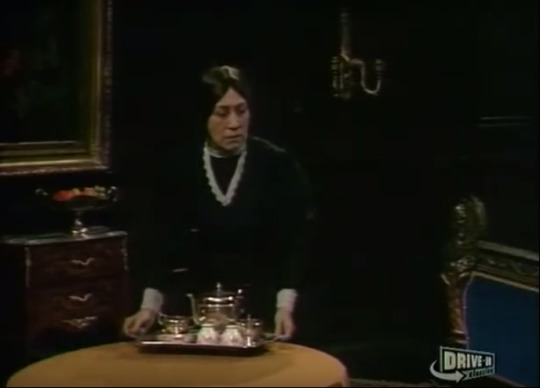
Raxl cuts him off when she enters the room, bringing tea as a pretext. “The master is not safe with a devil spirit in the room,” she tells him, no doubt wanting the fluffy devil spirit back so she can sacrifice it.

Jean Paul must see through Raxl’s flimsy pretext, given how dramatically he refuses the refreshments she brought. “Leave me, Raxl,” he hisses, mugging for the camera. “I do not want your tea!” Even after she offers to taste it first, he refuses.
Raxl leaves to visit the Great Hall, where she arrives just in time to overhear Elizabeth accusing her of poisoning Holly. After pissing off Elizabeth by giving her the stink-eye, Raxl sends Vangie upstairs to report to Jean Paul with the locket.
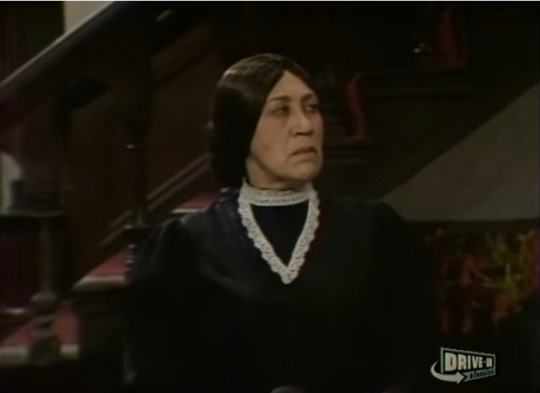
Raxl giving Elizabeth the stink-eye.

Elizabeth tries using the look as evidence that Raxl is working against them. Vangie doesn’t buy it.
While ranting to Quito in the crypt, Raxl recaps what she knows about Erica, the locket, and the Rabbit of Evil. She speaks of herself in the third person: “Raxl cannot tell them because they are fools!” This is a new thing, which Ian Martin’s Raxl never did. It’s also the second time this happens in the episode; the first instance occurs in the tea scene. where she asks, “Does the master wish Raxl to taste the tea before he drinks?” I don’t like it. I think referring to herself in the third person makes Raxl sound less intelligent than she’s proven herself to be.
Meanwhile, in Jean Paul’s room, Vangie dangles the sparkling locket like a pendulum before Jean Paul’s eyes:

Vangie: "Jean Paul Desmond…look at the locket…focus on the locket…focus as I swing it back and forth like a pendulum…you are now getting very relaxed…now, Jean Paul Desmond…now you will stop being mean and grumpy as you have been since the capsule malfunctioned…you will go back to being polite and charming like before and stop breaking everybody’s hearts…you will confess your love to Dr. Alison Carr…you will also stop looking constipated…Jean Paul Desmond…Jean Paul Desmond…"
I wish. No, she isn’t actually using it to hypnotize Jean Paul, just showing it to him so that he can inspect it. He verifies that it belonged to her and claims that he “put [it] on Erica’s throat with [his] own hands. I saw it sealed into the capsule with her, with these same eyes that see it now.”
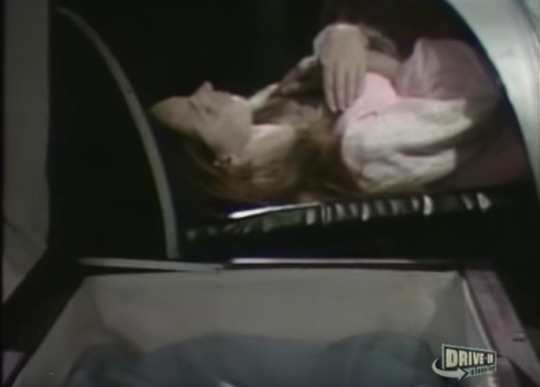
The line above is a retcon. In Episode 4, Erica was not wearing any visible locket when the men from the Cryonics Society insert her body into the cryocapsule. Jean Paul entered the crypt to see her after they had already sealed her in.
“Now, take it, Jean Paul,” Vangie orders. “Feel it. It is real!” She says this as though Jean Paul had just denied it being Erica’s, which is the opposite of his reaction. “I can touch it no more! Take it back!”
She hands it to him and he takes it. Even though he says it’s real and so does she, he still wants confirmation. “Touch it, Vangie!” he begs. “You must! How am I to save my mind? How else am I to know if it is true and real, what I am seeing?”
“Do you doubt your mind, Jean Paul?” Vangie asks, although it’s obvious that’s the only explanation for his command.
“This is the mystery,” he says. “This is the terrible fact I must find out, without this.” It’s not clear what specifically he means by this in either of those sentences. “Vangie, how can you make a contact?”
Not wanting to subject herself to a third dangerous séance on the island, Vangie tells him, “I’m sorry, Jean Paul. The séance is impossible. The angry spirit that came into this house with the locket and the black rabbit is still here, waiting. It can seize any one of us as it seized Holly. I will not do it!”
But Jean Paul insists that she must, or else “how will [he] be able to save [his] mind?”
“How much are you asking?” Vangie demands. “What are you doing to me? What are you doing to all of us?”

Speechless, Jean Paul doesn’t respond. After Vangie leaves the room, he clutches the locket to his chest. “How am I to save myself and my Erica?” he ponders, his eyes wide with terror.
Down in the Great Hall, Vangie vents to Matt and Elizabeth about how she doesn’t want to put them in danger by holding another séance, throwing the box that was on top of the séance table in anger. Elizabeth, remembering that Jean Paul had once seemed “such a reasonable man,” speculates that one of them may be able to reason with him.
Meanwhile, Jean Paul begins to speculate that someone has opened the capsule and continues his attempted interrogation of the very bored-looking rabbit:

Jean Paul: “Who are you? What are you? If I gave you the poisonous leaves here on Maljardin where nothing lives, would you die, or have you lived and dined on this vile island on poison?” Rabbit of Evil: “...”

Jean Paul: *obviously reading Teleprompter* "Or are you innocent? And if you are, then you would die blameless. Or is Raxl right? Was it evil that brought me the locket or good?"

Jean Paul: *unable to suppress a smile at the ridiculous monologue about the cute animal* "And which are you: good or evil?" Rabbit of Evil: *twitches nose cutely*
This scene is the crowning moment of cute on Maljardin, between Colin Fox’s unsuccessfully suppressed smile and the adorable rabbit twitching its nose at him. Eventually giving up on questioning the animal, he sets it back down in the picnic basket and returns to the matter of the locket.

“Yes!” he declares. “I can find these answers if the capsule is opened. And if there’s nothing there or the locket is there,”--he reads the Teleprompter some more--”then this is false!”
After a brief filler scene between Raxl and Quito--in which she, thankfully, is back to referring to herself in the first person--Matt visits Jean Paul in his room. Attempting to reason with him, the Reverend begs Jean Paul to confess if he is responsible for the things that have happened to Holly, between her being pushed down the stairs, the slashed portrait, and last episode’s poisoning. Jean Paul accuses him of plotting with the others on the island to gaslight him, then describes his new, bizarre theory about Dan removing the locket from the cryocapsule when it allegedly failed and dipping it in blood as part of their plot. But how did Dan get the blood? The only possibility, he believes, is that there was blood on Erica. This provides him with yet another reason to open the capsule: to see where and how Erica was bleeding, which he now claims he remembers happening.
Meanwhile, Raxl and Quito meet in their bedroom to discuss the necessity of finding the conjure doll and the silver pin. And the fact that they’re meeting in their room means...
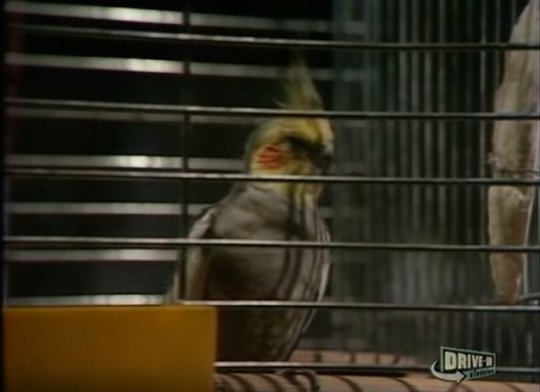
There he is, again: our mascot!

They leave to search in the Temple of the Serpent shortly after, and we get this well-lit shot of the passageway between the crypt and the temple.
Matt returns to the Great Hall and recaps his conversation with Jean Paul to Vangie, who comes to the conclusion that the situation on Maljardin is hopeless because Jean Paul doesn’t know the truth. At the same time, Raxl prays to the Serpent in the temple to tell her if the “woman-child” Holly should die, to which the answer is “yes.” She then orders Quito to “search” (for the doll and pin) and he screams!
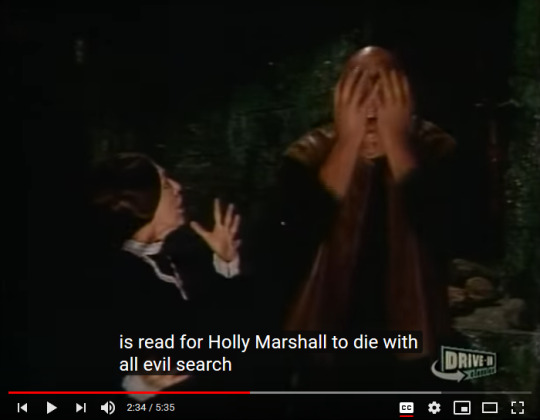
Quito screaming, with the moment’s location in the video of Part 3. Even though it’s not technically a line, I’m going to count this as a line flub because Quito is supposed to be mute.
Later in the Great Hall, Jacques speaks to Jean Paul through the portrait, telling him not to open the capsule. “You will learn nothing,” he argues. “You will finish off Erica for nothing. Don’t you think so? All you can learn is whether that machine works. Is Erica’s body perfectly preserved, or is Erica now something else?”

Obvious foreshadowing is obvious.
Ignoring him, Jean Paul retreats to the crypt, where he grips the capsule and cries, believing he must open it but fearing for Erica’s safety. Raxl finds him there and begs him to open it and let her die naturally, not just so he gets his answers, but also “so that she may have eternal peace with the god that you denied.”
“Are you, too, suggesting that I am mad?” Jean Paul asks.
“Open the capsule, do not open the capsule. If madness is to come, it may come right away," is her cryptic reply.
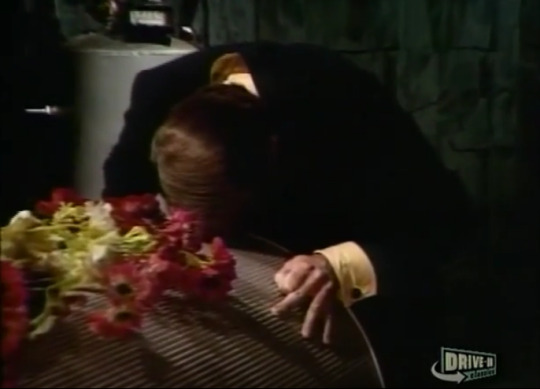
Jean Paul crying on the capsule from the episode’s final scene.
While not as good as the other Salverson and Chudley episodes to come, Episode 45 shows promise in its focus on Jean Paul’s descent into insanity. Once he realizes that the locket was Erica’s, he constructs a ridiculous conspiracy theory involving his enemy Dan removing it while tampering with the capsule and somehow getting blood on it. He feels tempted to open the capsule despite the danger to her frozen body, and now must choose between risking her permanent death by opening (what Raxl wants) and keeping it shut despite his mounting fears that the uncertainty will drive him mad, so that Jacques can resurrect Erica. The script has its issues and there are some amusing bloopers, but the first episode produced by Robert Costello is engaging and suspenseful, leaving the viewer with questions about what will happen and be revealed in Week 10.
Coming up next: The Bad Subtitle Special for Week 9, followed by two theories about Jean Paul’s new fears regarding Erica and the locket.
{<-- Previous: Episode 44 || Next: Episode 46 -->}
Notes
[1] Hatch’s Mill makes for an interesting footnote in SP history. In addition to sharing one writer and three actors in major roles, Peg McNamara (aka Peg Dixon, the first Ada Thaxton) and Patricia Collins (the first Huaco des Mondes) played minor roles in one episode. A scathing 1968 review by critic Douglas Marshall provides the most detailed description of Hatch’s Mill available for free online.
#strange paradise#george salverson#ron chudley#maljardin arc#week 9#episode 45#review#the bloodied locket#chalcko (quito's bird)#creative line interpretation#cryonics capsule#dark shadows#foreshadowing#hatch's mill#lost episode summaries#the missing cyanide#rabbit of evil#retcon#robert costello#teleprompteritis
2 notes
·
View notes
Audio
(agentkentucky)
Coloring Outside the Lines Episode 1: Making Machinima and the New Media Maze
~LISTEN ALONG~
WARNING: Volume Down. This one compressed pretty loudly this time around.
Transcript (with pictures! Most effective when paired with hitting play):
Hi everyone, my name is Erin Christopher aka Agent Kentucky, and you are listening to, “Agent Kentucky Presents: Coloring Outside the Lines: RWBY, Red vs. Blue, and the Rise of the New Media Community”. This four-week blogcast is being completed as a course requirement for my new media class at Florida State University and will use the creation and dissemination of the Rooster Teeth brand as a case study in the formation of new media communities and the impact of digital storytelling. Now, I feel like there was some jargon there, so I’m going to back it up a minute and talk about what new media is, why I’ve chosen to study this company, who I am as a host in relation to the topic, and then we’ll get into the focus of this week’s blogcast, which is making machinima and the new media maze. So, if you can’t tell, I’m a pretty big fan of wordplay and alliteration, sometimes it comes unconsciously so keep an ear out.
Anyway, if you’re not familiar with what Red versus Blue is, I’ll be explaining more in a little bit, but it’s best known as the longest-running episodic web series ever. Still, if you’ve never seen it, you might be wondering why I’ve chosen “Agent Kentucky Presents” as the title of a blogcast with a focus on Red vs Blue. So first of all I’m from Kentucky, and while yes I can do the stereotypical Kentucky accent, I will not be using it in this blogcast because I figure I grew up in Kentucky, this is my voice, this is a brand of a Kentucky accent. Don’t want to do anything disingenuous, here. But moving on, in Red vs Blue, the Rooster Teeth series that launched the whole company, there are 49 Agents called “The Freelancers”, who are named after US states, so you have Agent Texas, Agent Washington, Agent Carolina, but as it stands Agent Kentucky is still out there adventuring and has not yet shown up. So I figure, for my little blogcast, I’ll be the Agent Kentucky’s stand-in until the real Agent Kentucky makes their debut on Red vs. Blue—and, maybe they’ll have the stereotypical Kentucky accent.
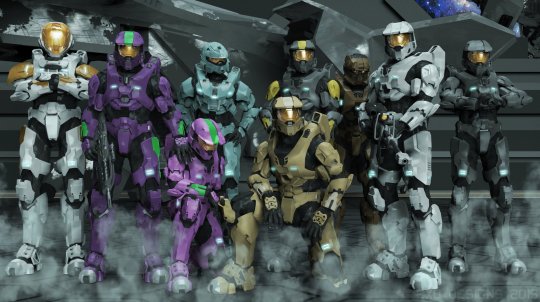
Caption: Say hello to the Freelancers! None of these cool kids are Red or Blue, but stand-in Agent Kentucky is goin’ rogue on the Blue Team (Go Cats?)
Moving on, I think I should explain what I mean by a new media case study before we jump too deep into this. So, within this field of new media studies—which is still really getting its footing in the larger academic world—we’re going to be looking primarily at these new ways stories and information are distributed via the Internet. Kind of delving in deeper into this rise of the web series that we really see coming to a bit of an apex today with the popularity and convenience of streaming, also YouTubers and the social media influencers. New media also encompasses things like the web comic, the visual novel, the listicle, the podcast, the fiction podcast—which has actually been my primary area of research for the past six months I’ve been doing my senior thesis, but the thing is we’d be here forever if I named off everything that counts as new media because it’s always growing and always changing, which makes it challenging to keep up with trends and shifts, but provides for a lot of diversity of material.
So, all research starts out with a core question, even though I’m going to be talking about a lot of different things regarding new media here in this blogcast, but my question I really want to focus on is about community and these web series. So RvB, RWBY, really anything that Rooster Teeth is putting out, you have gen:LOCK coming in January, which is this huge exciting new scifi series helmed by RWBY’s director Gray Haddock and Black Panther’s Michael B. Jordan, probably a more familiar name if you’re not familiar with RT’s stuff, but the point is part of this company’s success has grown out of a backbone of community.

Caption: Michael B. Jordan is back to snap some retainers (and pilot some bad*ss mechs) as the voice of Julian Chase, protagonist of the upcoming Rooster Teeth Animation series gen:LOCK
And I’m not just talking about audience—for the record, I will be referring to community and audience as totally different things. So you can watch something and never think about it again, hardly talk to anybody about it, it goes out of your mind—but you were still part of the audience. You consumed that commodity. Community, on the other hand, implies further engagement, it implies connection with other audience members, sometimes this brings about the production of transformative works, so we’re talking fanart, that sort of thing. All of this long explication here brings me to my central research question which is, “How is the niche web series a catalyst of community unbounded by geography?” So that rhymes a little but it’s still kind of jargon-y, so I am essentially asking here, what is it about web series like RvB that brings people together so passionately? And obviously, you have a lot of discussions like this going on right now about modern fandom, kind of concerning things on mainstream platforms, by mainstream studios, but I think there’s a personal element here when we’re talking about indie content, especially indie web content, that facilitates the development of a different kind of consumer community—there really are tons of these out there now, but I want to focus on the RT community specifically given their time frame, how they really were ahead of their time on these things. So, kind of presenting a thesis for my question here, I think niche has a lot to do with this development of community by the web series—you’re getting people engaging in conversations who have more specific intersections of interests, I also think creator-community connection has a lot to do with it which is really bridged through social media nowadays, and that’s kind of what we’re going to be exploring here through these four episodes.

Caption: The spectrum of Red vs. Blue Heroes
Which, nature of research, one question leads to another, why focus on these series specifically? For the most part, we’re going to be talking about Red vs Blue but later we’ll touch on RWBY, which if you’re not following along in the blog is spelled R-W-B-Y, it stands for the main characters’ names and the colors they’re associated with, and I’m not just doing this because it lets me make a cheeky little title about coloring outside the lines, but these series really have made a profound impact on the landscape of digital storytelling and what we think about when we produce visual entertainment for the Internet. And going off that, the ways in which these stories have brought so many people together. I think one of the reasons I really latched onto what this company does, especially after watching their fifteenth anniversary documentary Why We’re Here, which is also the title of the first episode of Red vs Blue, is because my own mission as a storyteller, as a screenwriter, a novelist is to write things that bring people together. Things people can talk about, make friends through. I’ve made of my some of my dearest long-distance friends over the years over just nerding out about stuff, so what I’m really curious about is what makes these niche series so powerful as a connective tissue among geographically disparate people.

Caption: Community comes together at the 2017 Rooster Teeth Expo (RTX) in Austin, Texas
So quick history lesson, in 2003, two years before the advent of YouTube, which has essentially become our society’s video hosting and consumption crutch, we see the birth of Red vs Blue, and subsequently the group that will become the founders of currently Austin, TX based Rooster Teeth Productions. Now with 16 seasons and 5 spinoff miniseries under its belt, Red vs Blue was created originally using playable characters in the shooter video game HALO, which was then overdubbed with comedic voice acting and released on Rooster Teeth founder Burnie Burns’ website, drunkgamers.com, where he and his friends, as the title suggests, would do the equivalent of Drunk History, but for video game reviews. The first official episode was released on April 1st, 2003, and the series actually found itself as part of a larger new media content movement called machinima, which was essentially the art of making movies out of video gameplay. Red vs Blue however has become probably the best-known example of this new media genre, having ballooned into the internet smash hit that it is today.
Not to say that there weren’t bumps in the road, however. After RvB started drumming up serious views, the crew got into some pretty hot water with Microsoft because, obviously, HALO was protected under their copyright. However, due to RvB’s massive success and the hordes of new players it actually brought the HALO franchise, the team at Rooster Teeth was allowed to use HALO footage to make Red vs Blue completely free of royalties.
Anyway, so the first episode of RvB, after it premiered in April 2003—see, I rhymed again—essentially became a viral video before the term viral video even entered our vernacular. Okay, say that ten times fast. But really, by the third episode, things were really taking off and the team had started to realize they had struck on something pretty special here. Which brings me to discuss, “how does Red vs Blue even fit into this greater new media genre of machinima?” For the record, I’d never even heard of this genre, or knew that there was a special genre for the type of production Red vs Blue is, and the creators didn’t know it either at the time, so I don’t feel as bad about it as I could.
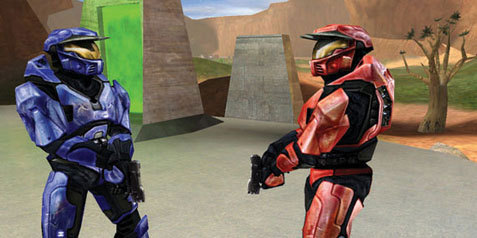
Caption: “What are YOU lookin’ at?”*
*Not the actual dialogue
Interestingly enough, there’s actually an Academy of Machinima of Arts and Sciences, that’s had its own film festival, awards show, and an expo convention that started in 2008. The first Machinima Film Festival and Awards were held in 2002, in which Anachronox: The Movie, a short film created using the 3D role-playing game Anachronox, took home best picture. A year later, the prize went to Red vs Blue: The Blood Gulch Chronicles. The first ever machinima films, however, were created around 1996 using the video game Quake. And similarly to Rooster Teeth, you had teams of producers—two of the big ones were called The Rangers and the Undead Clan, who created these early machinima films and distributed them via the Internet.
Now, even though it’s made using an action shooter game, Red vs Blue really isn’t all that much about the fighting—although there definitely is some, it’s certainly not like what you’re going to find in say, RWBY, where you’ve got these super crazy fight scenes and characters whipping out convertible weapons and all that. Rather, Red vs Blue is more about what happens in these humorous conversations among soldiers, and I think that’s one of the big appeals of it. So many times, content is focused on the action, kind of one of the fundamentals of structuring a plot is asking “is this important to the story? Is this important to the characters?” but Red vs Blue endeavors to make the non-fighting, the cracking jokes and dry humor, the focus, that’s the important stuff. There’s actually academic literature out there on RvB as a piece containing anti-war sentiment, I have it linked in the sources if you wanna check it out.
However, I also think RvB has a big appeal due to the interactive nature of the content, starting with its creation and continuing on into its distribution and consumption. So in an academic article on the art of machinima, Dr. Henry Lowood, who is a curator of science and technology history in the libraries at Stanford University, discusses this idea of the player—that is the player of a given video game—as a performer. Which, you know, machinima—the players become the animators, the modelers, the voice actors, but Lowood argues that this is inherent to video games, that the video game experience actually has laid the psychological groundwork for machinima to arise as a form of new media storytelling. So, when you’re playing a video game, especially an RPG, you are, for the most part, in control, you have to literally be inside your character’s head, making decisions for them. That’s why, when games are talked about or reviewed, you’ll see the word “immersive” thrown around a lot, and that’s because so many times when you’re playing video games you are placed into the psychological position of your playable character. According to Lowood, that makes you an actor.
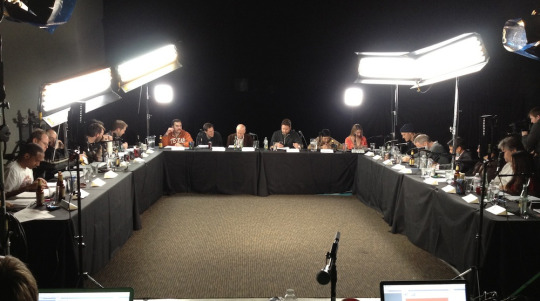
Caption: A table read of Red vs. Blue Season 10.
So, of course, machinima producers like the Rooster Teeth founders go the extra mile here, doing voice acting over staged video gameplay, but the point, according to Lowood, is that impetus to create is already there just through the act of playing a video game. So, if we’re looking at RvB’s production as something that amplifies player-game interaction into this new dimension, is it so much of a stretch to claim that that interactive nature is actually directly reflected in the creation of the Rooster Teeth community? Of course, the founders talk about in the documentary how the community forums were created so the fans could really just entertain each other while there were lulls in releasing content, but you also saw the founders having day-to-day engagements with their fans, sort of befriending them, they ended up actually hiring a bunch of their early fans like Gavin Free, Barbara Dunkelman, and Miles Luna who are now trademark company personalities, so you wonder if interactive was just kind of always in the blueprint, and of course carries on into the company mission today.
Finally, I really think that they’ve capitalized—as so many online content creators have—on the simple fact that people process information via narrative. Really, when you break it down, new media studies as a whole is kind of the study of how stories are connecting people. Via the internet, digitally. I mean really that’s intrinsic to the core of humanities, this idea of stories connecting people. All this to say, of course, that this concept of interactive creation, of including the consumer in the narrative, is kind of what it takes to lay the seeds of such a well-connected consumer community.
So, next episode I am going to dive deeper into this creation of community and I would really love to do a Q and A, maybe an interview, so if you’re part of the Rooster Teeth community and don’t mind me reading off your answers to a couple of questions, or if you want to ask me questions regarding this and my research on it, my ask box is open you just can’t send me anonymous messages—so don’t be shy, I only do that for my own safety and security, and you can always request that I not give away your URL when I do the Q and A. Anyway, thanks for tuning in, and we’ll be back with another episode next Friday.
~Peace out, and check out the bibliography under the cut.
AKY
BIBLIOGRAPHY
Lowood, Henry. “Real-Time Performance: Machinima and Game Studies”. Journal of Media Practice, vol. 2, no. 1, 2006, pp.10-17. https://web.archive.org/web/20060101161233/http://www.idmaa.org/journal/pdf/iDMAa_Journal_Vol_2_No_1_screen.pdf . Accessed 14 September, 2018.
Ott, J. “Academy of Machinima Arts and Sciences”. Making the Movie, 7 Aug. 2005, http://makingthemovie.info/2005/08/academy-of-machinima-arts-sciences.html . Accessed 14 September, 2018.
Starrs, D. Bruno. "Reverbing: The 'Red vs. Blue' machinima as anti-war film", 'Continuum: Journal of Media & Cultural Studies', NY, London: Routledge, 24.2, 2010, pp. 265–277.
Thompson, Clive. “The Xbox Auteurs.” The New York Times Magazine, 7 Aug. 2005, https://www.nytimes.com/2005/08/07/magazine/the-xbox-auteurs.html. Accessed 14 September, 2018.
Why We’re Here. Directed by Mat Hames, Rooster Teeth, 2018.
3 notes
·
View notes
Text
Women, friendship, books

My bookcase would probably not be considered Pinterest-worthy, but I am very proud of it despite its untidiness. Most books in it are written by women. I would dare say only 15 per cent of the names on the spines are male. If I delve even deeper into the contents of that mix of paperbacks and hardbacks, I can say that many talk about friendship…between women. Yes, I know, there is a bit of a pattern here. I love books about women. I remember once watching a panel of writers at Smith College and one of the guests was the novelist J. Courtney Sullivan. I had just read her first novel and loved it…and so I was watching the video on youtube just to see her speak. She talked unapologetically about how she was primarily interested in writing stories about women. Something clicked in me. I felt exactly the same way, but until she said it -someone I respected and admired- I hadn’t acknowledged it, not even to myself. We are so burdened by the deprecating so-called ‘chick lit’ that some of us can be ashamed to admit we want to read -and write- stories about women. All kinds of stories. And this shouldn’t degrade the work. Why are stories about women and girls not taken as seriously as the ones about men?
Female friendships are complex. According to Deborah Tannen, author of the 2017 book “You’re the only one I can tell: Inside the language of women’s friendships”, women friends know a lot more about each other than their male counterparts. “The tendency is for talk to be a bigger part of women’s friendships. So you get together, you get coffee, you take a walk, and you talk, you talk about what’s going on in your life and you talk about other things too. The tendency for men is to be more focused on the activity. So you get together to do something…and you talk while you’re doing it. But the focus tends to be more on the activity…”
Conversation leads to deepening your knowledge of another person’s life and mind, which leads to intimacy. So it’s no wonder that women’s friendships are so gratifying. The more you know someone, the more prone you are to understanding them. However, this close bond can also make the relationship more complicated. While researching her book, Professor Tannen listened to women talk about their female friendships as “the most sustaining thing” in their lives…but she also heard “Women don’t let you be different”.
The intricate bonds that tie women together seem to be all over our screens nowadays. Television shows are exploring the complicated relationships between girls and women like never before: from the endearingly funny duo in Pen 15, to the sassy women of Big Little Lies, and don’t even get me started on the new generation of the Baby-sitters club. However, no medium can portray the nuances in female friendships like literature.
From my messy bookshelves to -hopefully- yours, here are some of the stories that have captivated me the most.
For the nostalgic ones:
Anne of the Island by Lucy M. Montgomery
Eighteen-year-old Anne has left Green Gables for university in nearby Nova Scotia, where she will finally fulfill her dream of earning a degree. She sets up home in a cozy cottage in bustling Kingsport with Avonlea’s Priscilla Grant and a new friend, the beautiful Philippa Gordon. But it’s not all fun and games. Anne’s childhood friend, Ruby Gillis, dies of tuberculosis back in Avonlea, shattering Anne’s carefree attitude to life, and Gilbert finally declares his feelings and proposes. But Anne still has a naïve, overly romantic view of love and rejects him, driving a wedge between them. A two-year relationship with a fellow Redmond College student, Roy Gardner, follows, but when he also proposes, Anne realizes that he’s not the one for her after all. When she returns to Avonlea and learns that Gilbert is deathly ill with typhoid, she is distraught. Will she recognize the depth of her feelings at last? Or is it already too late for Anne and her one true love?
For the aspiring artists:
The Animators by Kayla Rae Whitaker
In the male-dominated field of animation, Mel Vaught and Sharon Kisses are a dynamic duo, the friction of their differences driving them: Sharon, quietly ambitious but self-doubting; Mel, brash and unapologetic, always the life of the party.
Now, after a decade of striving, the two are finally celebrating the release of their first full-length feature, which transforms Mel’s difficult childhood into a provocative and visually daring work of art. But with their success come doubt and destruction, cracks in their relationship threatening the delicate balance of their partnership. Sharon begins to feel expendable, suspecting that the ever-more raucous Mel is the real artist.
A funny, heartbreaking novel of friendship, art, and trauma, The Animators is about the secrets we keep and the burdens we shed on the road to adulthood.
For the teen take:
Dare me by Megan Abbott
Addy Hanlon has always been Beth Cassidy's best friend and trusted lieutenant. Now they're seniors who rule the intensely competitive cheer squad, feared and followed by the other girls -- until the young new coach arrives. Cool and commanding, an emissary from the adult world just beyond their reach, Coach Colette French draws Addy and the other cheerleaders into her life. Only Beth, unsettled by the new regime, remains outside Coach's golden circle,
Then a suicide focuses a police investigation on Coach and her squad. After the first wave of shock and grief, Addy tries to uncover the truth behind the death -- and learns that the boundary between loyalty and love can be dangerous terrain.
For an emotional ride:
The Girls from Corona del Mar by Rufi Thorpe
Best friends Mia and Lorrie Ann couldn’t be more different; where Mia is reckless and proudly hard-hearted, Lorrie Ann is kind, serenely beautiful, and seemingly immune to the kind of teenage mistakes that Mia can’t help but make.
But within a few years, fortunes change. Suddenly, Mia is free to grow up and adventure, falling in and out of love while Lorrie Ann is weighed down by responsibilities at home. And when good, nice, brave Lorrie Ann stops being so good, Mia must question how well she ever really knew her best friend in the first place.
0 notes
Text
Plans for this blog
This is just a quick post to state what I intend to do over the coming months with this blog.
I’ve always wanted to blog but worried that it had fallen “out of fashion” with the age of YouTube and the like. Do people even still search for blogs? I, myself, only bump into them when I have a question that needs answering or a worry that needs quelling.
But then I realised that that’s not the point. I am a writer and I want to write. It would be idiotic to stall because I worry no one will read it. I don’t intend for this blog to suddenly “take off” and become my livelihood; it is simply something I want to do, somewhere where I can go and express myself.
As I said before, I am a writer - and hopefully, soon to be published novelist - and primarily wish to use this as a means to get my work out there and connect with other writers.
I want to write about my life and my opinions on things as well as my stories and writings. I have many thoughts that keep me awake at night and I feel this is the place to let them loose! I am also contemplating reviews of books/movies/games if inspiration strikes.
I guess any more than that would be spoilers but I hope you stay tuned with me on this journey!
0 notes
Text
Rewriting My O.S. with Self Help Books
I love self help books. LOVE THEM. I guess that statement would lead you to think I’m really messed up, and you’re not wrong, I guess. But I love them for a different reason.
Most consumers of self help books will likely read “The Secret” or whatever, it will change their life, and then move on to their usual Danielle Steel or James Paterson novels.
But for me, self help books are a practice, like jogging, or meditating, or playing the piano. Maybe even like a religion? And reading them is like looking at the universe through a prism, and turning that prism so reality appears slightly differently. Learning this ability is like updating or rewriting my own operating system.
A lot of the books I like are about creativity and writing. Although I am not a writer per se (like a novelist or journalist), a lot of the concepts apply. For example, there’s a technique from Mark Levy’s “Accidental Genius” called “try easy” that I like a lot. Basically, instead of trying to write the next great American novel –and being paralyzed by the pressure of writing something that’s so called “great”– instead, try writing something obvious and straightforward. Then you can relax, and write about what comes naturally. This same approach can be applied to art, or writing music, or photography, or whatever. The idea is to stop overthinking and making it perfect.
While some books are about specific techniques like that, others are more about “being inspired.” A great example is “Big Magic” by Elizabeth Gilbert. In that book, Ms. Gilbert presents reasons, anecdotes, and ideas meant to inspire the reader to do whatever it is they are meant to do. I can’t recall any practical, tangible advice, really, but my recollection from reading the book is a fond burst of energy and motivation.
And that is important. I’m a pretty motivated guy broadly speaking, but damn, life can just grind away at you, day by day. And as a person engaged in an artistic venture, it’s easy to become jaded, and to run out of proverbial gas. Therefore, reading a book that puts some fire back in my heart is nice, even if there isn’t any actionable suggestions, or even if I’ve already heard some of the “help” before.
That’s what I mean by self help books being a “practice:” an ongoing, renewing, of ideas and motivation.
But this also applies to books with actionable advice or techniques. Very often, books overlap each other’s ideas and techniques. But not entirely...maybe about seventy percent. And sometimes, even the overlapping ideas may have different perspectives that you personally understand better in one iteration or the other.
For example, Austin Kleon is well known for his easy-reader “Steal Like an Artist.” But that book heavily draws on Hugh MacLeod’s “Ignore Everybody.” There is a bit of overlap, but Mr. MacLeod’s book is very different in tone and attitude. Leon’s book is very bright and optimistic, while MacLeod’s book is very cynical and kinda dark (this may be a Millenial/Gen Xer thing). But both books have something to offer.
There is another genre of self help books, often called “management” books. They blur the line with business sometimes. But they still have things to offer. One book from a few years ago was “Designing Your Life” by Bill Burnett and Dave Evans. The book primarily pushes the reader to create various life plans in order to achieve their dreams or goals. But frankly, my main takeaways were that I learned about “mind mapping” and “rapid iteration” techniques.
There are a few books, however, that have a magic cross over of both “technique” and “inspiration.” The best one I have encountered is “The Artist’s Way” by Julia Cameron, which was shared with me by my very good friend. This book is certainly not a secret, but it was new to me last year. And it really rung my bell on multiple fronts. In fact, the book is supposed to be a six- or twelve- week process. Well, I was so energized by both the techniques and inspiration that I never finished the book. That’s a good thing. I simply ran out of time, because I was working on so many things.
Another interesting book I came across recently, was “The Bullet Journal Method.” From the title, you can deduce that it primarily informs the reader about how to start bullet journaling. But once it deals with that, the book morphs into self help territory, utilizing the bullet journal as its tool. The self help components are actually pretty appropriately framed, in terms of breaking goals down into steps, planning, that sort of thing. I felt this is a contrast to many other self helps where it’s all “THIS WILL CHANGE YOUR LIFE FOREVER!” writ large and over hyped.
So reading a lot of self help books, trying different creative (and life) techniques is how I’ve been re-writing my own personal operating system. And by changing my brain thus, I have seen, like, actual changes in my life. Not radical changes, like growing tentacles, becoming a circus clown, or moving to Antarctica, but developing a sense of clarity, creativity, and productivity.
And in many ways, altering my own O.S. has altered the way I experience reality. For example, I use the “morning pages” practice from “The Artist’s Way” to exorcise, externalize and figure out my issues, great and small. I dealt with my anxiety while playing with the help of the book “Effortless Mastery” by Kenny Werner. I helped develop my feelings about the universe with the help of a series of books (and audio lectures) by Alan Watts. And I learned to meditate with a few books, but also some self-help YouTube videos, which is a topic for another time.
But this actually addresses another point. Sometimes, a self help book reveals something you do NOT believe, or like. I read a book about lucid dreaming, how to have lucid dreams, and how to use dreams to improve one’s life. I realized, however, that I didn’t like the idea of being in control of my dreams, and I didn’t want to be productive while I’m asleep. It was just a bridge too far.
Compared to ten years ago, I’m the same person, but really, I’m a different person. I’m kind of living a different life, because I have a different mind. Maybe it’s just the kind of person I am, but I can’t be content without constant learning, growing, and bettering myself. But I find that tweaking my brain, and therefore my knowledge and experience of reality and this universe, to be endless fulfilling and fascinating.
#self help#selfhelp#creativity#theartistsway#juliacameron#austinkleon#changeyourbrain#rewriteyouros#bigmagic#elizabethgilbert#hughmacleod#ignoreeverybody#effortlessmastery#kennywerner#marklevy#accidentalgenius
0 notes